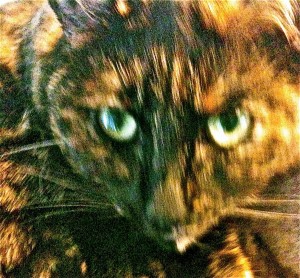
You can argue about where it all started (or even what it is) but I’d rather take the tack of looking at the authors that shaped the genre. Let’s begin, accordingly, with Laurell K. Hamilton, who started so much with her heroine, Anita Blake. Necromancer and private investigator, Blake kicks ass and takes names, at least early on in the series, which begins with Guilty Pleasures. (did Hamilton know the direction she’d go in from the first? The title seems to hint in that direction.) In the early books, Anita is tough as nails and prone to smartassery. She’s got two love interests: Richard the werewolf and Jean-Claude the vampire and, unlike a lot of romances, you don’t know what will end up happening. It’s great stuff.
Certainly Hamilton wasn’t the first person to write about vampires. The writer who had moved them into popularity was Anne Rice with her vampire series, which began a couple of decades earlier with Interview with the Vampire. On one level a sexy, intriguing story, the series also spoke to an anxiety floating around in the American zeitgeist at that point: sex and blood had become problematic with the arrival of AIDs. Its popularity rose as did media mentions of the disease.
But Hamilton came along and created a very specific vampire mix. She added Anita Blake, a tough but reader-identifiable character who was a smart-ass, had love-life problems, and tried to solve mysteries. Honestly, how could the series not be a hit? Blake first appeared in 1993, while four years later the TV series Buffy the Vampire Slayer would teach vampire lore to a new generation of readers who would soon discover Anita and her rapidly increasing ilk.
Somewhere along the line, though, the Anita Blake series…turned. Was that Hamilton discovered that sex sells or that with success she was freer to write the sort of thing she wanted to? Soft core porn began to get sifted in with a heavy hand, and none of it was vanilla. I don’t mind that, though. It’s fascinating to get a well thought out take on what sex with supernatural beings would be like. There are, unfortunately, some moments where it overshadows everything else. I’m thinking of Micah in particular, and if she stuck to the pattern of that book, I’d be about done. Luckily, she doesn’t. I like the fact that Anita has multiple lovers, that she’s in control, and that she changes her attitudes over time. But the books have become a guilty pleasure – although still, let’s admit, pleasurable when she maintains the balance between sex and storyline, and I’m certainly still buying them and, on occasion, re-reading them too.
Hamilton’s other series, the Merry Gentry books, which begins with A Kiss of Shadows, follows the same pattern. It’s a fascinating world, but sometimes we don’t get to see it because we’ve spent so much time in the bedroom. The overarching story line is that of a Faerie princess who must get pregnant. In case you don’t understand the implications, here’s a hint: Fairies do not reproduce through mitosis, but rather through lots of hot sex.
Again, a fascinating world, with a rich mythology and a premise that paves the way for plenty of nifty little jokes and eyeball kicks. Sometimes we don’t see as much of it as we’d like because we’re watching Merry get merry between the sheets, but it’s well-written and steamy sex that sometimes transcends space and time and/or summons ancient elemental forces. I found the most recent one I read, Divine Misdemeanors, which featured a serial killer of demi-fay who was using the tiny bodies of the victims to stage elaborate tableaus, nicely creepy and memorable.
So tell me what you think. Is Hamilton a guilty pleasure for you too or are you on some other terms with her books?
And for those interested in the books, here’s the lists, in chronological order:
Anita Blake:
- Guilty Pleasures (Kindle)
- The Laughing Corpse (Kindle)
- Circus of the Damned(Kindle)
- The Lunatic Cafe (Kindle)
- Bloody Bones(Kindle)
- The Killing Dance (Kindle)
- Burnt Offerings (Kindle)
- Blue Moon (Kindle)
- Obsidian Butterfly (Kindle)
- Narcissus in Chains (Kindle)
- Cerulean Sins (Kindle)
- Incubus Dreams (Kindle)
- Micah (not available on Kindle)
- Danse Macabre (Kindle)
- The Harlequin (Kindle)
- Blood Noir (Kindle)
- Skin Trade (Kindle)
- Flirt (Kindle)
- Bullet (Kindle)
Merry Gentry





9 Responses
I’m in the process of rereading the Anita Blake series again and I have to agree that there comes a point at which Anita loses a lot of the characteristics that make her so relatable and becomes rather whiny. The sex scenes are great but they to tend to dominate too much. There were points, like Mistral in the Meridith Gentry series, where I wished for more plot and less porn but I think there is a trend developing to go back the other direction and find that happy medium. I hope so at least. Laurell K Hamilton is one of my favorite authors and will be for a very long time.
I gave up on the Blake series after #7 and only read the first book of the Gentry series. Gentry to me was sex with next to no plot and a pointless book. And the Blake books just became a mess and changed their focus too much for me.
The first 6 or 7 though? Ate those up! Granted, they were more fun than college essays, but I also had never seen anything like them and LOVED the books themselves. I started noticing technical issues in book 4, then Anita ended up being totally different, and then sex seemed to become the primary purpose of the books. Once that happened, I was done.
Alas, my first introduction to Laurell K. Hamilton, was “Micah.”
One of my first encounters with Urban Fantasy stories, and the one that shaped my idea of the genre, was Emma Bull’s “War for the Oaks.”
John – I love “War For the Oaks” – I’m planning on talking about that in a future entry. Such a good book! On Facebook Annie Bellet mentioned Robin McKinley’s “Sunshine” as another great urban fantasy.
I loved Hamilton’s first half dozen blake novels. I can’t stand anything past that. I don’t mind a little sex thrown in, but not to the exclusion of a plot. I was told recently that the series was getting better, but I couldn’t tell it from Flirt. She has totally lost the voice of her charachter.
That’s how I felt after Micah, which seemed to be entirely about the sex (or rather a specific aspect of it), with a couple of bullet shots here and there. Lately she’s seemed to be moving back towards actual plot – at least it felt that way to me in Obsidian Butterfly and Skin Trade.
But it sure would be interesting to see a book set in that world (I presume it’s the same world in both series, but I may be entirely wrong on that) in which we got to wander around in places other than the bedrooms.
My future husband introduced me to the Anita Blake books. I read through “Burnt Offerings” (though I somehow skipped “Bloody Bones”) and enjoyed the first novel through “Lunatic Cafe.” He stayed with the entire series through “Obsidian Butterfly.” I have no doubt the later books are also well-written, but the author is no longer writing for either of us. (Perhaps because he was a much more devoted fan than I ever was, my husband refers to the later books as “fanfic” and “PWP books.”)
As a side note, I rather suspect Chelsea Quinn Yarbro’s vampire romances in turn paved the way for Rice’s novels.
Actually, I’m pretty sad that while I like a few a these series they’ve taken over *so* much. When I go to my local cheap-dept-store-that-carries-books, the entire shelf area that is labeled “Science Fiction” has 2 science fiction books and is chock-a-block with these series books. And guess what also fills the romance and “Popular Author” shelves?
This is just a little too much for me, especially as I’m way more a fan of the War for the Oaks type urban fantasy than I am of Hamilton (I’ve bounced off Hamilton the couple of times I’ve tried).
I am glad to hear you say that her books got better after Micah. I was a big fan until I picked that one up and than promptly threw it across the room at the midway point. Maybe I’ll have to give some of her post-Micah books a chance.